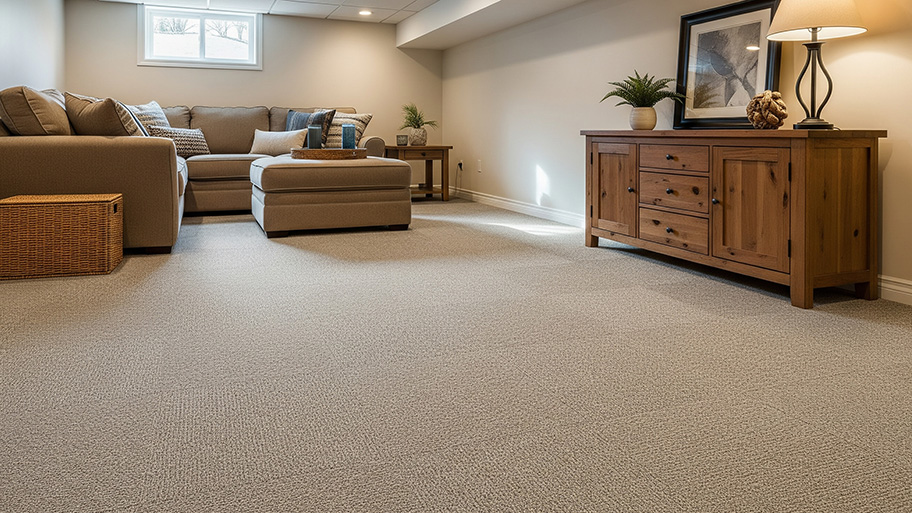
Carpet padding makes your carpet feel extra comfortable and protects your floors from damage, but how much does carpet padding cost? Let’s look at the numbers.
Goodbye, eyesore—and hello, beautiful carpet


It’s easy for your carpet to go unnoticed—until an accident leaves an unsightly hole. It could be from a burning ember from your fireplace or an excited dog that thinks digging into your carpet is a good idea. Whatever it is, you can learn how to patch carpet and get it back to looking as good as new.
Yes, it’s possible to patch a hole in your carpet, saving you from having to take any drastic measures like recarpeting the entire room. The DIY process is best for small carpet holes up to around 1 square foot.
It’s best to fix a hole in your carpet as soon as possible; not only is it an eyesore, but it can cause other issues, like a trip hazard. Additionally, your underlayment is now exposed, so if you accidentally spill any liquids, the moisture can easily penetrate your subfloor. This can lead to water damage, mold, and mildew.
You’re ready to fix your small carpet problem, but where do you begin? The best place to start is by finding a piece of replacement carpet for your patch. If you’re lucky, you might have some spare carpet from when you originally installed it.
Otherwise, you have a couple of choices. The low-budget option is to find a piece of carpet in your house that’s normally not visible and simply cut out a piece for your repairs. Or, you can hunt down the same type of carpet and color at the store. If you have paperwork from your carpet installer, it’ll help you determine the exact color you should look for. You might even get away with getting a free carpet sample, depending on what’s available.
The following are three different methods for patching a hole in your carpet. You may find that using a carpet repair kit is the easiest option since it comes with the tool you need to repair the hole precisely and quickly. However, if you’d like to save a few bucks, the other methods can work just as well.
If the problem area is bigger than a few inches, the carpet repair kit or can method might not work since they’re not big enough to cover the area. In that case, use the screwdriver method.
Grab your carpet repair tool. It shouldn’t have the blades on yet, but take them off if they’re already on there. Then, place the tool onto the carpet with the problem area in the middle. Turn it a few times in the clockwise direction.
Attach the blades and the pivot screw to your carpet repair kit. Line up the tool with the imprint you made on the carpet in the previous step, then press down until the pivot screw punctures the carpet. Next, press down and turn the tool clockwise three times. Lastly, pull out the carpet piece.
Take the replacement carpet piece and place it onto a cutting mat. Repeat steps 1 and 2 to cut your replacement piece.
Grab the circular glue piece from your kit and place it underneath the hole in the carpet. Then, activate the glue by dabbing it with water and letting it sit for a few minutes.
Before you do any gluing or taping, first figure out the direction of your carpet fibers. To do this, run your fingers across the top of the carpet and see which direction the fibers fall. Once you’ve figured that out, take your replacement piece and check the fiber direction on it.
Apply your bottle of carpet seam glue along the edge of the circular opening. Grab your replacement carpet piece, line it up in the correct fiber direction, and press down.
Wait 15 minutes or so for the glue to set. Check the directions for your repair kit for drying times.
Finally, take your star wheel carpet seam roller and roll it along the seams until they disappear.
Find an empty can or anything circular, and place it on top of the damaged carpet. Press down and twist the can a few times in the clockwise direction.
Place the can onto the imprint, and grab your utility knife. Carefully and slowly follow the curve of the can as you cut into the carpet.
Next, take your new carpet and cut out the replacement piece following steps one and two. Put the carpet on a cutting mat or something solid like concrete so you don’t accidentally cut into the carpet beneath.
Apply carpet seam glue to the back of the replacement piece, starting in the center and moving outwards in a circular pattern. Then, place it into the opening with the fibers in the right direction. Press down firmly.
The last step is to use your star wheel carpet seam roller. Press the seams with the roller until they blend into the rest of the carpet.

If you don’t have anything on hand to use, use a ruler and screwdriver to draw a square around your hole (making an imprint).
Use a utility knife and cut out the square shape you made with the screwdriver. Use a ruler to help you make straight cuts.
Take your new carpet piece and lay it face down. Then, grab the carpet piece you cut out in the second step and place it on top. Trace the edges of the old piece with a pencil. Use a utility knife to cut the replacement piece to size. Cut on top of a cutting mat to avoid cutting into your other carpet.
You can use carpet seam glue or carpet tape. For the glue method, follow the instructions in the previous section. If you go with the tape, you’ll need to apply it on all four sides of the square (remove the backing and place each piece halfway under the carpet so it shows through the opening).
Grab your replacement carpet piece, install it in the correct fiber direction, and press down.
Use your star wheel carpet seam roller to blend the seams into the rest of your carpet.
Sometimes accidents happen, but here are some do’s and don’ts to avoid holes in your carpeting:
Place rugs in front of fireplaces to protect your carpeting from embers and ash.
Supervise children and pets in carpeted areas and watch out for spills.
Avoid smoking and using candles in carpeted rooms.
Use ironing boards when ironing to reduce the risk of burning the carpet.
Replace your carpet every five to 15 years, which is about the normal life span for carpet.
High-traffic areas require flooring that can withstand frequent use, children’s shoes, scurrying paws, and dirt or stains. Installing an easy-to-clean floor that will last on stairs, hallways, or in the kitchen may be worth the long-term investment.

Learning how to fix a hole in your carpet is a task most beginner DIYers can handle. If you decide to splurge on a carpet repair kit, it will cost you about $35 to $50. However, if you’re not interested in learning how to fix a hole in carpet or want to avoid adding another item to your to-do list, you can hire a carpet removal pro near you to help.
You can expect professional carpet repair costs for burn damage, tears, or snags to range between $130 and $300, depending on the size and severity of the issue.
From average costs to expert advice, get all the answers you need to get your job done.

Carpet padding makes your carpet feel extra comfortable and protects your floors from damage, but how much does carpet padding cost? Let’s look at the numbers.

The average range to remove carpet costs $120 to $720. Contractors base carpet removal costs on square footage, home location, and installation type.

Not only are carpet tiles easier to install than carpet, but they’re often more affordable. So, how much does carpet tile installation cost? Let’s take a look.

Carpet face weight is one factor that indicates a carpet’s quality. Learn what carpet face weight is, when it matters, and how to choose the best weight.

Carpet repair, refastening, or stretching can make an old carpet look new again. Consider these questions when requesting quotes from carpet repair pros.

Between wool versus nylon carpet, which should you choose? Your carpet will be under your feet for years to come, so picking the right material is crucial.